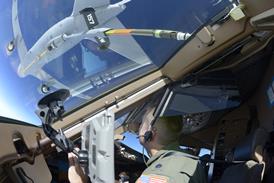SELECTION OF a single contractor, to develop the Joint Direct Attack Munition (JDAM), is scheduled for 11 October. Lockheed Martin and McDonnell Douglas (MDC) are competing for the contract to produce global-positioning/inertial-navigation (GPS/INS) guidance kits for 74,000 US Air Force bombs.
The JDAM guidance kit will be used to upgrade the Mk83 450kg, Mk84 900kg, and BLU-109 450kg penetrator bombs, providing an accuracy of 13-30m on INS guidance only. The contract will cover more than 600 kits required for testing on a wide range of aircraft, including the Northrop Grumman B-2 and Lockheed Martin/Boeing F-22.
Lockheed Martin has dropped four JDAMs during testing so far, including one separation-test and two unguided control-test vehicles. One guided JDAM has been dropped, and a further test is planned for October, this time against a target. MDC has elected not to conduct any release tests.
Northrop Grumman, meanwhile, is proposing a larger version of its GPS-Aided Munition (GAM), under development as an interim precision-guided weapon for the B-2 until the JDAM can be brought into service.
The GAM, now undergoing final testing before deliveries begin early in 1996, is a Mk84 bomb equipped with steerable fins and a GPS receiver. Northrop Grumman has a $25 million contract to deliver 128 GAMs to arm 20 B-2s. Testing during the last quarter of 1995 will combine the GAM with the GPS-Aided Targeting System, which fuses data from the B-2's radar with information from GPS satellites.
The larger GAM now proposed is based on the BLU-113 penetrator bomb and, at 2,130kg, is more than twice as heavy as the Mk84. Extra fins on the middle of the bomb would give the additional lift required. Northrop Grumman says that the B-2 could carry up to eight of these munitions and would gain "significant" penetration capability.
Rockwell, meanwhile, has submitted an unsolicited proposal to produce a GPS tailkit for the Mk82 225kg bomb, to give the B-1 a precision-guided-munitions capability before the JDAM is available. Seven weapons have been released in tests and a further drop is planned.
The tailkit would be available 12 to 15 months after contract award, Rockwell says.
Source: Flight International























